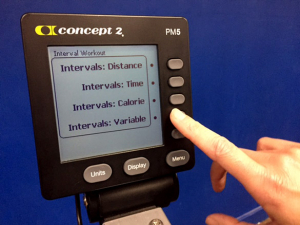7 Reasons to Include Intervals in your Workouts
As we follow the research on exercise and health, we’re finding more and more reasons to incorporate intervals into our training. Below is a summary of the benefits they may offer, with some links to further reading if you’re interested.
Interval training means alternating between bursts of high-intensity work and periods of rest or easy effort. The work intervals do not need to be long—they can be as short as 10 seconds—but you should put good effort into them. Then rest for up to several minutes before doing the next one. Sample interval workouts are provided at the end of this article.
1. Effectiveness
A growing body of research is showing that interval workouts are effective at improving fitness—often more effective than longer steady state work. Specifically, several studies have looked at the effectiveness of Tabata intervals (see sample workout below).

2. Variety
Long steady work can get boring. Some people thrive on the data provided by the PM; others need entertainment. Interval workouts provide structure and ask you to vary your intensity regularly, which goes a long way to preventing boredom! Vary your exercise routine by including several interval workouts and several steady-state sessions in the course of a week.
3. Time-efficiency
Given the research showing that intervals are at least as effective as longer steady-state intervals, they are a time-efficient way to get in an effective workout. Even if you only have a half hour, don’t give up on getting in a workout. No excuses!
4. Weight loss
Because of the higher intensity of interval work, you will burn more calories for longer after your workout than with lower intensity workouts. This is called EPOC, Exercise Post Oxygen Consumption.
5. Blood sugar control
High intensity intervals appear to be effective in controlling blood sugar and improve insulin sensitivity. This may be of special interest to diabetics and those with pre-diabetic conditions.
6. Blood pressure control
Another recent study showed that HIIT can improve several measures of cardiovascular health including blood pressure.
7. Anti-aging
If all the other reasons aren’t enough, recent research compared different types of exercise and found that while all exercise was beneficial, interval training had the greatest positive effect in reversing, or improving certain affects of aging at the cellular level. While we can’t expect to really turn back the hands of time, it’s worth slowing them down with some interval training.
Workouts
Always spend at least 5 minutes warming up before beginning an interval workout.
- Tabata intervals: 8 x (20” max, 10” easy). It’s a 4 minute workout that accomplishes a lot. The PM can even help you with Setting Up a Time Interval Workout.
- Minute on/minute off: alternate between 1 minute at good intensity and 1 minute very easy. Start with 10 minutes total, and increase toward 20 minutes as you are able. If you’re just starting your training, and/or are dealing with any health issues, it’s always advisable to check in with your medical professional.
- More favorite interval workouts from Concept2 employees.
References
- On HIIT, from the American College of Sports Medicine (ACSM): http://www.acsm.org/all-blog-posts/acsm-blog/acsm-blog/2017/10/26/interval-based-exercise-many-names-possibilities
- Interval Training and Blood Pressure: https://www.nature.com/jhh/journal/v31/n3/full/jhh201662a.html
- Intervals for Aging Muscles: https://www.nytimes.com/2017/03/23/well/move/the-best-exercise-for-aging-muscles.html
- Enhanced Protein Translation Underlies Improved Metabolic and Physical Adaptations to Different Exercise Training Modes in Young and Old Humans: http://www.cell.com/cell-metabolism/fulltext/S1550-4131(17)30099-2
- High intensity interval training (HIIT) improves resting blood pressure, metabolic (MET) capacity and heart rate reserve without compromising cardiac function in sedentary aging men http://www.sciencedirect.com/science/article/pii/S0531556516306003
- Diabetes and Blood Sugar Control: https://www.ncbi.nlm.nih.gov/pmc/articles/PMC4334091/
- General Benefits: https://well.blogs.nytimes.com/2015/01/26/sweaty-answer-to-chronic-illness/
